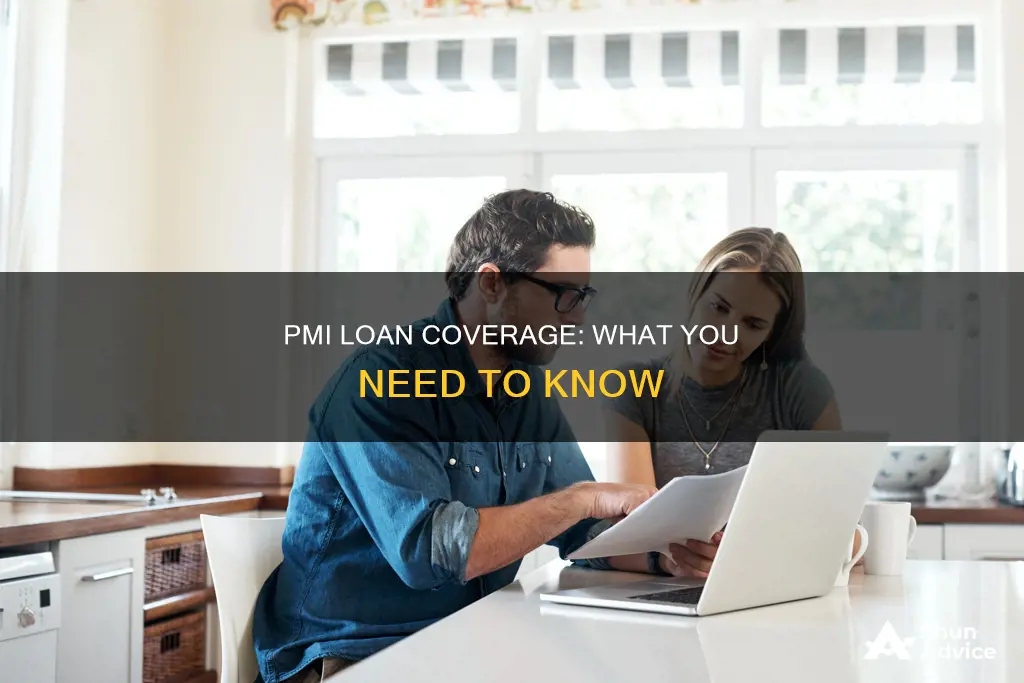
Private Mortgage Insurance (PMI) is an extra expense for borrowers who take out a conventional loan with a down payment of less than 20% of the purchase price. It is designed to protect lenders against losses if borrowers stop making payments. PMI does not protect borrowers and they can still lose their homes through foreclosure. The most common way to pay for PMI is through a monthly premium, which is added to the borrower's mortgage payment. However, PMI can also be paid through a one-time upfront premium or a combination of upfront and monthly payments. PMI can help borrowers qualify for a loan that they might not otherwise be able to get, but it increases the cost of the loan.
| Characteristics | Values |
|---|---|
| What does PMI stand for? | Private Mortgage Insurance |
| Who does PMI protect? | The lender, not the borrower |
| Who needs PMI? | Those who take out a conventional loan with a down payment of less than 20% |
| How much does PMI cost? | Between 0.3% and 2% of the original loan amount each year; the exact amount depends on your credit score and down payment size |
| How is PMI paid? | Monthly premium; one-time upfront premium; or a combination of both |
| Can PMI be cancelled? | Yes, once the loan-to-value ratio reaches 78% or falls below 80% |
What You'll Learn

PMI is an added expense for borrowers
Private mortgage insurance (PMI) is an added expense for borrowers who take out a conventional loan with a down payment of less than 20% of the purchase price. PMI is arranged by the lender and provided by private insurance companies. It protects the lender and not the borrower, compensating for the extra risk assumed by the lender when extending a larger loan with a lower down payment. The cost of PMI depends on the loan and down payment size, the type of mortgage, and the borrower's credit score. The most common way to pay for PMI is through a monthly premium added to the borrower's mortgage payment. However, there are also options to pay with a one-time upfront premium or a combination of upfront and monthly payments.
The requirement to buy PMI usually applies when refinancing a conventional loan, where the borrower's equity is less than 20% of the home's value. PMI can increase the overall cost of the loan, making it more expensive. Borrowers can avoid PMI by making a 20% down payment or opting for a government-backed loan, such as an FHA or USDA loan, which have their own associated fees.
While PMI can help borrowers qualify for a loan they might not otherwise obtain, it is important to consider the additional financial burden it imposes. The cost of PMI can vary, typically ranging from $30 to $70 per month for every $100,000 borrowed, according to Freddie Mac. The borrower's credit score also impacts the cost, with higher credit scores generally resulting in lower PMI rates.
Borrowers can request to cancel PMI when their mortgage balance reaches 80% of their home's value, or lenders may be required to cancel it when the balance reaches 78%. Additionally, PMI was tax-deductible through the 2021 tax year, but this deduction has not been renewed as of the latest update. Overall, while PMI may facilitate loan approval, it represents an added expense that borrowers should carefully consider in their financial planning.
Pawn Shops: Understanding Title Loans and Their Process
You may want to see also

PMI is required for conventional conforming loans
Private Mortgage Insurance (PMI) is an added expense for borrowers who take out a conventional loan with a down payment of less than 20% of the purchase price. It is an extra fee for a conventional mortgage for borrowers putting less than 20% down. The PMI typically costs between 0.3% and 1.5% of the loan amount annually and is added to the borrower's monthly mortgage payment until they reach 20% equity in the home. Once your home equity reaches 22%, your PMI payments will automatically stop.
There are a few different ways to pay for PMI. The most common way is through a monthly premium, which is added to your mortgage payment. Sometimes, you can pay for PMI with a one-time upfront premium paid at closing, or you may pay with a combination of upfront and monthly premiums. In a split-premium PMI arrangement, you pay a larger upfront fee that covers part of the overall insurance costs, and the remainder is paid with your monthly mortgage payment.
Lenders sometimes offer conventional loans with smaller down payments that do not require PMI. As a trade-off, you usually pay a higher interest rate for these loans. It is important to consider the potential impact on your taxes and overall cost when deciding between paying a higher interest rate or PMI.
Pawn 1 Title Loans: What You Need to Know
You may want to see also

PMI protects the lender, not the borrower
Private mortgage insurance (PMI) is a type of insurance that protects the lender if the borrower defaults on a home loan. It is important to note that PMI protects the lender, not the borrower. While PMI can help the borrower qualify for a loan they might not otherwise be able to get, it does not protect them from foreclosure if they fall behind on mortgage payments.
PMI is typically required when the borrower makes a down payment of less than 20% on a conventional loan. The cost of PMI depends on various factors, including the loan amount, down payment size, interest rate, credit score, and type of loan. Borrowers can pay PMI through monthly premiums, a one-time upfront premium, or a combination of both.
It is worth mentioning that PMI should not be confused with mortgage protection insurance (MPI). Unlike PMI, MPI is a type of life insurance that protects the borrower. MPI covers mortgage payments in the event of job loss, disability, or death. MPI is voluntary and is not required by lenders.
While PMI provides protection for the lender, it is an added expense for the borrower. Borrowers can avoid paying PMI by making a down payment of 20% or more on their home. Additionally, borrowers can request to cancel PMI when their mortgage balance reaches 80% of their home's value. Lenders are also required to cancel PMI when the balance reaches 78% of the home's value or halfway through the loan term, whichever comes first.
In summary, PMI is designed to safeguard the lender's interests in the event of borrower default. It is important for borrowers to understand that PMI does not offer them protection but rather increases the cost of their loan. Borrowers should carefully consider their options and seek advice from a financial advisor before deciding whether to proceed with a loan that requires PMI.
PennyMac's HELOC Loan Options: What You Need to Know
You may want to see also

PMI can be paid monthly or as a lump sum
Private mortgage insurance (PMI) is an added expense for borrowers who take out a conventional loan with a down payment of less than 20%. It protects the lender in the event that the borrower defaults on their loan.
PMI can be paid in a few different ways. The most common way is through a monthly premium, which is added to your mortgage payment. Alternatively, you can pay for PMI with a one-time upfront premium at closing. In some cases, you may pay with both upfront and monthly premiums.
Upfront PMI, also called a "single premium", allows you to pay the entire premium in one lump sum at closing. This option can give you the benefit of lower monthly mortgage payments. However, it may not be a good choice if you don't plan on staying in your home long enough to recoup the cost of the premium. Additionally, upfront PMI may not be refundable if you refinance your home.
Split-premium PMI is another option, where you pay a larger upfront fee that covers part of the overall insurance costs, and the remainder is added to your monthly mortgage payment. This combines the pros and cons of single-premium and borrower-paid PMI, as you'll have a lower upfront cost and more manageable monthly payments.
Lender-paid PMI is a third option, where the lender pays the PMI premium on your behalf, and you agree to a higher mortgage interest rate. While this option may not be ideal for some taxpayers, it can be beneficial for those who itemize their taxes, as mortgage interest is deductible.
The decision to pay PMI upfront or monthly depends on your financial situation and goals. Monthly PMI may be a good choice if you want to keep your closing costs lower and spread out the cost of PMI over time. On the other hand, upfront PMI can result in lower monthly payments and eliminate the need to request a PMI cancellation later on.
Why Does Owning Sell Their Loans?
You may want to see also

PMI can be cancelled under certain circumstances
Private mortgage insurance (PMI) is a type of mortgage insurance that you may be required to purchase if you take out a conventional loan with a down payment of less than 20% of the purchase price. PMI protects the lender if you default on your loan, but it does not protect you—you can still lose your home through foreclosure if you fall behind on your mortgage payments.
PMI can be removed under the right circumstances. Here are some ways to cancel PMI:
Request for Removal
You can request to remove PMI from your loan once you have reached 20% equity in your property. This typically means you have earned 80% LTV (Loan-to-Value) or 20% equity in your home. You will need to provide an appraisal that proves your loan balance isn't more than 80% of the current value of your home. You must also have a great payment history and be up to date on all your payments. Additionally, you may have to show that you don't have any other mortgages on the home.
Automatic Termination
Your servicer is legally required to automatically terminate PMI on the date when your principal balance is scheduled to reach 78% of the original value of your home. To qualify for automatic termination, you need to be current on your payments.
Halfway Through the Loan's Original Term
Your lender or servicer must end the PMI the month after you reach the midpoint of your loan's amortization schedule, even if the principal balance has not reached 78% of the original value of your home. This scenario is more likely to occur for people with a mortgage with an interest-only period, principal forbearance, or a balloon payment.
Refinancing
You can also consider refinancing your mortgage loan. If you refinance a conventional loan with a new loan amount that meets the 80% LTV requirement, the new loan will not have PMI added.
It's important to note that the requirements for removing PMI may vary depending on the type of property and the loan servicer. It's always a good idea to consult with your lender or servicer to understand their specific PMI cancellation guidelines and to ensure that you meet all the necessary criteria before requesting PMI removal.
Ondeck's Loan Ownership: Who Holds the Debt?
You may want to see also
Frequently asked questions
PMI stands for Private Mortgage Insurance. It is an added expense for borrowers and is required if you buy or refinance a home with a down payment under 20%. It protects the lender in case you default.
No, PMI does not cover the entire loan. It is designed to protect lenders against losses if borrowers stop making payments. It does not protect you and you can still lose your home through foreclosure.
The most common way to pay for PMI is through a monthly premium. The premium is added to your mortgage payment. Sometimes, you can also pay for PMI with a one-time upfront premium paid at closing.
The best way to avoid PMI is to make a down payment of at least 20% of the home's purchase price. You can also consider a government-backed loan such as an FHA or USDA loan, which does not require PMI.







